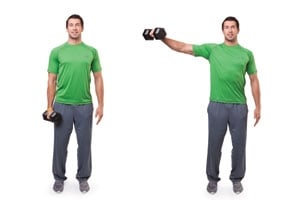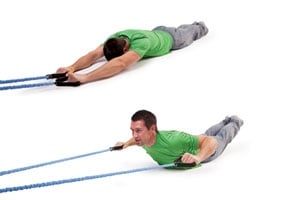
If you don't use proper exercise technique when working out, you run the risk of injury. Our safety tips will ensure you have a fun - and a safe - workout.
Loud grunting. Sweat left on benches. Chatting on a mobile phone. Likely, one of these actions makes your list of irritating things people do at the gym. What grinds my gears? When people put their health and safety at risk by doing exercises improperly or without attention to form.
Daily, without fail, I see people in the gym doing exercises that are dangerous and more harmful than good. Fitness can be a minefield at the best of times. There’s a vast array of information out there on how to tone your buns, sculpt your arms or (my personal favourite) blast your belly fat.
There are thousands of exercises to tighten and tone your body, but how is one to know which ones are truly beneficial and which ones can ruin your body? Believe it or not, it is actually quite simple.
Proceed with caution
First and foremost, I believe there are no bad exercises, only bad exercisers. Any movement can be beneficial when done with form, focus and appropriate resistance. Many of the issues associated with bad form are a result of the exerciser using resistance that is beyond their abilities.
The following are some popular exercises for shoulders, lats and abdominals that hold high correspondence with bad form and put you at risk every time you do them. But fear not, for in their place I will provide alternative exercises that target the same muscles, but will give you better results!
Abdominal muscles
Don’t do this: Straight leg abdominal lifts
Lying on their back, as if in bed, exercisers arch their lower back until it looks like an alien is going to burst out of their tummy. They lift their straightened legs into the air above them, whereupon they let their legs come crashing back to the ground. That is one ... one ugly exercise, that is.
Hip flexors are easily strained from this position. The lower back muscles, as well as lumbar vertebrae, are at serious risk. The worst part? This is a really ineffective exercise for abdominals. The movement contracts the muscles but doesn’t lengthen or shorten them, and so optimal activation is minimal.
Do this: Reverse crunches

- Lie on your back with your hands underneath the lower edge of your pelvis (edge of your butt), palms flat on the floor.
- With a slight bend in your knees, raise your legs above your hips so that your lower body bends at the waist at a 90-degree angle.
- Shift your body weight into your upper back, lifting your tailbone off the ground.
- At the same time, push your hips forwards in the direction of your head, extending your legs straight into the air as high as you can.
- Bring your legs back into a bent position as you lower your tailbone back to the ground and to starting position.
Shoulders
Don’t do this: Barbell high row
This exercise for your shoulders puts the rotator cuff in a position of weakness while under a load and has been known to shear the ends of the clavicle where it meets the humerus. The exercise is done standing upright and holding a barbell with hands hip-width apart. You then slide the bar up along your body up to shoulder height while raising your elbows out to the sides. Many do it with momentum and a back sway. Just don’t do it.
Do this: Single arm lateral dumbbell raise

- Stand with a dumbbell in hand, feet shoulder-width apart with head, hips and spine in neutral position.
- With a slight bend in your elbow, raise your arm out to the side so that your elbow and wrist raise up to shoulder height at the same time (your palm should be down).
- After a slight pause, slowly return your arm to starting position. Avoid any extracurricular body movement or leaning to either side.
Head-to-toe tips for proper form
Always pay special attention to form throughout the duration of an exercise. This will not only prevent injury, but also promote good posture, and you’ll achieve better results.
- Keep head positioning neutral and your jaw relaxed.
- Keep shoulder blades down and back.
- Hold the spine in a neutral position, and regardless of the exercise, consciously and actively engage your core muscles.
- Maintain hips in a neutral position.
- Focus on having slightly bent “soft” knees that track overtop the toes when bending and squatting for most exercises.
- Point toes straight forwards.
Latissimus dorsi muscle (lats)
Don’t do this: Lat pulldown behind the head
Exercisers on the pulldown machine crane their neck forwards. With an almost abdominal crunch sway, they yank the bar down to the back of their neck. It may target the lats, but it immediately puts the cervical vertebrae at risk as well as creating a risk for strained trapezius muscles and various rotator cuff injuries.
Do this: Laying resistance band pulldown

- Lie on your stomach with your head pointing towards a resistance band fastened at floor level.
- With the front side of your body resting against the floor, grasp the handles in front of you and proceed to pull your elbows to your sides while keeping your head up and arms and hands close to the ground.
- Slowly return to starting position.
Reps and sets for beginners
For strength
- perform at least 1 set of 8 to 12 reps
- increase gradually to 2 to 3 sets
For endurance
- perform at least 1 set of 10 to 15 reps
- increase gradually to 2 to 3 sets
Born free
As a personal trainer, I am often asked what machines I recommend most to someone trying to lose weight and gain strength. My answer is always: none. Whenever possible (it is always possible), choose to do free weight or body weight exercises. More often than not, these kinds of exercises force you to work your core while you work other muscles.
Machines allow you to sit. They support you and basically teach you laziness and dysfunction. Ask a certified personal trainer to show you some free weight exercises, and consult your local nutrition or health food store to get the most out of your workouts.




